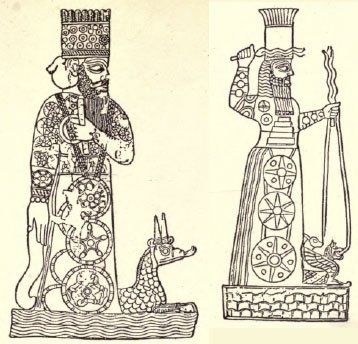The civilization of Babylonia and Assyria
Its remains, language, history, religion, commerce, law, art, and literature
by Morris Jastrow | 1915 | 168,585 words
This work attempts to present a study of the unprecedented civilizations that flourished in the Tigris-Euphrates Valley many thousands of years ago. Spreading northward into present-day Turkey and Iran, the land known by the Greeks as Mesopotamia flourished until just before the Christian era....
Part VIII
We have still to consider one of the most notable figures of the Babylonian-Assyrian pantheon, one whose cult assumed great prominence in the earliest days to which we can trace back the history of the country with which we are concerned, and who retained his position despite all political and social vicissitudes, throughout all changes in religious thought down to the disappearance of the Babylonian-Assyrian civilization the moon-god, Sin. There were chiefly two centres of Sin worship in Babylonia, one at Ur in the extreme south, and the other at Harran in the north.
The former of these two is the older and by far the more important. By the side of Sin, the moon-god also bears a name, Nannar, which designates him as a "luminary". In Sumerian the name is written with two signs, En-zu, which describes him as the "lord of knowledge" and of which Sin divided into Si-in may be a derivative by an inversion of the two syllables, which is not uncommon. [1]
These two qualities, as a light-giving power and as a god of wisdom, are the two traits of Sin most prominently dwelt upon in votive and historical inscriptions and in religious texts. In the art, [2] the moon-god is represented as an old man with a flowing beard, with the moon's crescent as his symbol. On the so-called Boundary Stones, [3] the crescent alone is used for the moon, as the circle with numerous rays stands for the sun.
The horns suggested by the moon's crescent were probably a factor in representing him also figuratively as a bull, and a frequent epithet given to him is "the young bullock of Enlil", which illustrates also the endeavor to associate him with the old Babylonian pantheon grouped around the god of Nippur. The crescent also suggests a bark, and in very old invocations he is pictured as sailing across the heavens in a bark. One of these reads in part as follows: [4]
"In the resplendent bark of heaven, self-appointed ruler,
Father Nannar, lord of Ur,
Father Nannar, lord of E-gishshirgal, [5]
Father Nannar, lord of Namrasit, [6]
Lord Nannar, first-born son of Enlil,
As thou sailest along, as thou sailest along,
In the presence of thy father, in the presence of Enlil, thou art ruler;
Father Nannar, thou art ruler, thou art leader,
In the bark riding through the heavens, thou art ruler."
In this manner the litany proceeds, the lines of which are evidently intended to be chanted by a leader and chorus alternatively, or by two choruses of priests. Though Sin or Nannar is constantly addressed as father in his capacity as the chief luminary in the starry heavens, the endeavor is clearly made to bring him into association with Enlil whose first-born son he is therefore declared to be, and in the course of the process of the incorporation of the Sin cult into that centring around Enlil, the "word" which we have seen is the specific quality of the chief god of Nippur in his role of a storm deity is likewise transferred to Nannar, as it was transferred to Marduk, to Shamash, to Ea and in fact to all the chief figures of the pantheon, quite independently of their original character.
PLATE XXX

Fig. 1 (left), The Chief Deity of Babylon
Fig. 2 (right), Adad, the God of storms
Footnotes and references:
[1]:
So we have Zu-ab, "house of knowledge", becoming apsu.
[2]:
See Plate LXXVII, Fig. 2.
[3]:
See p. 416, seq.
[4]:
Gun. Texts, XV, PI. 17, and Reisner, Sumerisch-Babylonische Hymnen, No. 3
[5]:
Name of Sin's temple in Ur.
[6]:
"Rising in light", an epithet of the moon-god.
